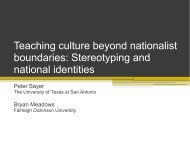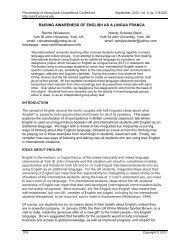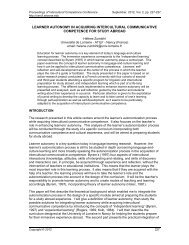BYRAM VERSUS BENNETT: DISCREPANCIES IN THE ... - CERCLL
BYRAM VERSUS BENNETT: DISCREPANCIES IN THE ... - CERCLL
BYRAM VERSUS BENNETT: DISCREPANCIES IN THE ... - CERCLL
Create successful ePaper yourself
Turn your PDF publications into a flip-book with our unique Google optimized e-Paper software.
Paula Garrett-Rucks Byram Versus Bennett<br />
areas and group-specific skills that facilitate cultural interactions” (p. 11). Sercu (2005) defined<br />
intercultural communicative competence (ICC) in FL education as a learner’s ability to cope with<br />
intercultural experiences. She further described the intercultural competencies and<br />
characteristics as:<br />
the willingness to engage with foreign culture, self-awareness and the ability to<br />
look upon oneself from the outside, the ability to see the world through the<br />
others’ eyes, the ability to cope with uncertainty, the ability to act as a cultural<br />
mediator, the ability to evaluate others’ point of view, the ability to consciously<br />
use culture learning skills and to read the cultural context, and the understanding<br />
that individuals cannot be reduced to their collective identities. (p. 2)<br />
Byram (1997) underlined the importance in FL education to move beyond an understanding of<br />
communication as an exchange of information but rather to “understand and relate to people<br />
from other countries” (p. 5). He defined successful communication in FL learning as the ability<br />
of learners to “establish and maintain relationships” (p. 3). Byram (2000) described the<br />
attributes of a person with intercultural competence communicative competence as:<br />
…someone who is able to see relationships between different cultures—both<br />
internal and external to a society— and is able to mediate, that is interpret each<br />
in terms of the other, either for themselves or for other people. It is also someone<br />
who has a critical or analytical understanding of (parts of) their own and other<br />
cultures—someone who is conscious of their own perspective, of the way in<br />
which their thinking is culturally determined, rather than believing that their<br />
understanding and perspective is natural. (p. 9)<br />
Described by Hoyt (2012) as “a constellation of notions” (p. 94), Byram’s multimodal model<br />
contains prescriptive definitions and 28 performance assessment objectives centering on<br />
learners’ attitudes, knowledge, skills, and critical cultural awareness. Byram (2000) described<br />
successful intercultural learners as “conscious of their own perspective, of the way in which their<br />
thinking is culturally determined, rather than believing that their understanding and perspective<br />
is natural” (p. 10).<br />
Echoing Byram’s definition of a successful intercultural learning, Bennett underscores the<br />
importance of understanding and accepting diverse cultural perspectives in order for individuals<br />
to shift from ethnocentric to ethnorelative ways of responding to cultural differences in his<br />
Developmental Model of Intercultural Sensitivity (DMIS). Bennett (1993) defines intercultural<br />
sensitivity as individuals’ psychological ability to deal with cultural differences. Hammer and<br />
Bennett (2001) described learners with basic intercultural sensitivity as able to recognize and<br />
accept the complexity of cultural differences as “different constructions of reality” (p. 12). There<br />
currently exist a large number of practices that have been recommended and implemented for<br />
assessing intercultural competence depending on the particular definition or model of<br />
intercultural competence adopted. The following section presents a brief review of some of the<br />
most salient quantitative and qualitative practices I found to assess intercultural competence<br />
across the literature.<br />
EXAMPLES OF QUANTITATIVE IC ASSESSMENT TOOLS (BASIC, ICSI, CCAI, IDI, AND<br />
<strong>IN</strong>CA)<br />
Many of the aforementioned studies in the review of the literature used surveys and<br />
questionnaires that were either designed by the researchers, or adapted from pre-existing IC<br />
assessment tools. Four salient types of assessment tools in the professional literature are for<br />
observers’ assessment of others (BASIC), self-reports (ICSI, CCAI and IDI), or a combination of<br />
<strong>CERCLL</strong> ICC Proceedings 13





